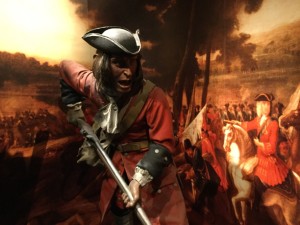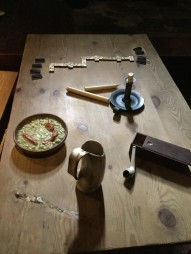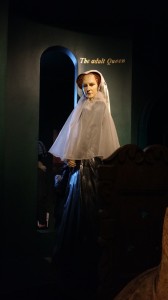
This November I visited Edinburgh, Scotland, enjoying the medieval city centre in particular and exploring the city’s history and literary tradition. Below are my highlights from this fantastic trip (all photos are mine).
![IMG_0738[9128]](https://ideasonpapyrus.files.wordpress.com/2019/11/img_07389128.jpg?w=225&h=300) I. Edinburgh Castle
I. Edinburgh Castle
Situated on the Castle Rock, Edinburgh Castle “has been the centre of Scottish life for more than 900 years, serving as a royal palace, arsenal, gun foundry, state prison and infantry barracks”. Now, it hosts a number of museums, showcasing Scotland’s rich, complicated and dramatic history. I thought the experience of Edinburgh Castle was just amazing, and it is worth its entry price. There is much to explore inside, from the Royal Palace (where Mary Queen of Scots gave birth to James VI), the magnificent Great Hall and the museum that preserves the crown jewels to the National War Museum, Museum of the Royal Scots and the new barracks.
 There is also the Scottish icon Mons Meg, a medieval bombard, to see, and the castle prison vaults to explore that detail the history of castle imprisonment (see more details below). Moreover, there is the Dog Cemetery and St. Margaret’s Chapel to explore. The Chapel is the oldest surviving structure in the castle and was previously a chapel to St. Monenna. It is best to visit Edinburgh Castle around one o’clock noon because there is then a chance to see the spectacular, even if mock, firing of a gun. The firing of a gun at one o’clock is a tradition stemming from 1861, though initially it was probably a practice to help Scottish ships to navigate.
There is also the Scottish icon Mons Meg, a medieval bombard, to see, and the castle prison vaults to explore that detail the history of castle imprisonment (see more details below). Moreover, there is the Dog Cemetery and St. Margaret’s Chapel to explore. The Chapel is the oldest surviving structure in the castle and was previously a chapel to St. Monenna. It is best to visit Edinburgh Castle around one o’clock noon because there is then a chance to see the spectacular, even if mock, firing of a gun. The firing of a gun at one o’clock is a tradition stemming from 1861, though initially it was probably a practice to help Scottish ships to navigate.
 The castle’s Prisoners of War exhibition is fascinating. From 1777 to 1812, the castle served as a prison for foreign soldiers and sailors. In the dungeons of the castle, there are cells on display where mainly French, American and Irish prisoners were held. As the displays say, the prisoners’ daily food rations consisted of “2 pints of beer, 1 1/2 pound of bread and 3/4 pound of beef”, plus some cheese on weekends. Americans (who were considered pirates) and soldiers labelled as rebels were treated more harshly and only received bread and water. Prisoners also had a lot of free time on their hands, and some used it to play domino or other games (see the picture to the right), or create objects of art. Some prisoners used that time to forge banknotes.
The castle’s Prisoners of War exhibition is fascinating. From 1777 to 1812, the castle served as a prison for foreign soldiers and sailors. In the dungeons of the castle, there are cells on display where mainly French, American and Irish prisoners were held. As the displays say, the prisoners’ daily food rations consisted of “2 pints of beer, 1 1/2 pound of bread and 3/4 pound of beef”, plus some cheese on weekends. Americans (who were considered pirates) and soldiers labelled as rebels were treated more harshly and only received bread and water. Prisoners also had a lot of free time on their hands, and some used it to play domino or other games (see the picture to the right), or create objects of art. Some prisoners used that time to forge banknotes.
There were instances in history when members of the local population felt sympathy for the prisoners’ plight and their living conditions. For example, there is one story of Reverend Fitzsimmons, a benevolent, popular man with connections, who notoriously harboured four French castle-escapees in his home, as well as arranged for their escape into France. The amazing thing is that it is said that, upon finding out about his treason, he only got a sentence of three months’ imprisonment (having good defence in court through his connections).
 One other well-known Edinburgh Castle story concerns the so-called Black Dinner. This is the event of 24 November 1440, detailing the alleged fate of sixteen-year old William, Sixth Earl of Douglas. William’s family was a powerful, respected and feared family at that time with once friendship connections to William Wallace. As the family was so powerful, it was also hated in certain circles, including in circles close to the royalty and by Sir Alexander Livingstone and Chancellor William, Baron of Crichton. After his father Archibald died, ambitious William and his younger brother David were invited to Edinburgh Castle for a feast with sovereign James II. It so happened that young William entered the castle being accompanied only by his younger brother and his father’s trusted adviser. William and his brother ate a hearty meal, chatting gaily with ten year-old James II, but, near its end, they saw that they had been served a black bull’s head, which was a symbol of death. At this point, William, his brother and the adviser were overpowered, dragged from the dinner chamber and beheaded, with Crichton and Livingstone ordering the executions in spite of the protests from young James II. Unfortunately for Crichton and Livingstone, the peaceful times ended at that point, and the Clan Douglas declared the war on the Castle.
One other well-known Edinburgh Castle story concerns the so-called Black Dinner. This is the event of 24 November 1440, detailing the alleged fate of sixteen-year old William, Sixth Earl of Douglas. William’s family was a powerful, respected and feared family at that time with once friendship connections to William Wallace. As the family was so powerful, it was also hated in certain circles, including in circles close to the royalty and by Sir Alexander Livingstone and Chancellor William, Baron of Crichton. After his father Archibald died, ambitious William and his younger brother David were invited to Edinburgh Castle for a feast with sovereign James II. It so happened that young William entered the castle being accompanied only by his younger brother and his father’s trusted adviser. William and his brother ate a hearty meal, chatting gaily with ten year-old James II, but, near its end, they saw that they had been served a black bull’s head, which was a symbol of death. At this point, William, his brother and the adviser were overpowered, dragged from the dinner chamber and beheaded, with Crichton and Livingstone ordering the executions in spite of the protests from young James II. Unfortunately for Crichton and Livingstone, the peaceful times ended at that point, and the Clan Douglas declared the war on the Castle.
II. The Writers’ Museum
This small but informative museum (entry is free of charge) is dedicated to three Scottish writers – Robert Burns (1759 – 1796), Sir Walter Scott (1771 – 1832) and Robert Louis Stevenson (1850 – 1894). I thought it was a cosy place that provided an invaluable insight into the lives of these three great Scotsmen. There were objects on display from Sir Walter Scott’s childhood, such as his rocking horse, as well as the printing press on which his novels were initially printed. Robert Burns’ possessions included his writing desk, journals, manuscripts and numerous paintings. Items on display belonging to Robert Louis Stevenson were his pipe and riding boots from his time in Samoa, among other objects (see the picture below).


 III. St. Giles’ Cathedral
III. St. Giles’ Cathedral
Founded in 1122, this beautiful cathedral has its own unique history to unveil (Saint Giles is the patron saint of lepers). It was twice the seat of a bishop in the seventeenth century and was the place from which John Knox, a minister, directed the country’s Reformation. It has an impressive exterior; the magnificent Thistle Chapel inside; and a number of beautiful stained glass windows. I thought it was worth visiting, even if it currently has a rather aggressive donation service at the entrance, which also asks you to pay to take any photos of the objects inside.
IV. Surgeon’s Hall Museums
Since I love exploring the history of medicine and science (see also my post on London’s Wellcome Collection), Surgeon’s Hall Museums, founded in 1505, was a must-go place for me. It is a large museum, encompassing the History of Surgery Museum, the Wohl Pathology Museum and the Dental Collection, and there you can “explore over five hundred years of surgical history”. It has hundreds of bones, tissue, body parts and full skeletons that have genetic or other abnormalities on display, as well as past surgical instruments and paintings that show fascinating medical cases. It is also possible there to learn about Scotland’s first public dissection, about the progress of Sir Joseph Lister in the development of antiseptic surgery, and about the crimes of Scottish serial killers William Burke and William Hare, who sold their victims’ corpses to medical establishments for dissection in 1828. Some of the items on display are not for the faint of heart, and photography is forbidden in the museums (therefore, I did not take any pictures).



V. Grassmarket
Grassmarket is now a historic market place in the city’s old town that boasts lively pubs, restaurants and boutiques. However, it also notoriously had a public place where executions used to take place (the Last Drop pub now stands as an ominous reminder of that activity). To the south of Grassmarket, there is Greyfriars Kirk, a medieval parish. However, tourists now flock to see Bobby, Greyfriars Kirk’s most famous resident, a statue of one fiercely loyal dog (Skye Terrier) that in its time spent fourteen years guarding the grave of its master until its own death in 1872. The Greyfriars Bobby’s Bar (see the central picture above) can be found near the site. Another curious case in the history of Edinburgh concerns William or Deacon Brodie, a Scottish cabinet-maker, who maintained a double life because he was also a burglar. Writer Robert Louis Stevenson was so impressed by Deacon Brodie’s duality that he took his story as an inspiration for his own book Strange Case of Dr Jekyll and Mr Hide. There is now Deacon Brodie’s Tavern, as well as Deacon’s House Café in Edinburgh.
 What to Buy
What to Buy
Souvenir shops on the Royal Mile sell quality cashmere wool clothing, exquisite celtic jewellery, whisky and other souvenir items related to Scotland. One can also go on a tour of one of the distilleries in Edinburgh. My biggest surprise, however, was all the amazing Harry Potter shops that can put the flagship HP shop at King’s Cross in London to shame. For book lovers, there are a number of great independent bookstores (such as Golden Hare Books), but, due to the lack of time, I only managed Blackwell’s and the Scottish Storytelling Centre, which I thought was a great place to buy local authors’ books on the city’s history, on Scottish and Celtic folklore, and books to brush-up one’s Gaelic.


Ah, this sounds like an amazing trip, I’d love to travel to Scotland someday! Your photos are beautiful, and all of your stops sound so interesting! The Last Drop pub does indeed sound ominous. But I’ll have to keep the Harry Potter shop in mind if I ever get there!
LikeLiked by 1 person
Thank you, it was a great place to visit, definitely exceeded my expectations!
LikeLiked by 1 person
I loved walking the cobble streets with you Diana, it is such an amazing place isn’t it. I lived there for a few years and it puts other cities to shame in terms of how beautiful it is. At night especially with the mist, it is incredibly mysterious. I am so glad to hear that you went to the Scottish Storytelling Centre, that is really lovely. I don’t think I remember any of these other book shops you mention. Did you get some great Celtic books there? Can’t wait to read the reviews!
LikeLiked by 2 people
That is great to know you lived there, and I got that “mysterious” feel from Edinburgh, too! I only bought a small book Tales of Edinburgh Castle at the Scottish Storytelling Centre, but I was tempted left and right by all the amazing Celtic and mythology books. I got some already, perhaps I will review some of them one of these days.
LikeLiked by 1 person
Look forward to your thoughts on that book. Scotland is a place for great history. The castle is a place that had a lot of creepy and amazing things happen in it, but all the other castles in Scotland as well have interesting histories. I miss it a real lot for the history…it is the kind of place that draws you back. Also, the people there are really down to earth and lovely too which makes it easy to make friends 🙂
LikeLiked by 1 person
Fantastic post, Diana💜 Thanks for sharing your trip.
LikeLiked by 1 person
Thank you, and thanks for reading! 🙂
LikeLiked by 1 person
YES I LOVE BORDERS, GREAT POST AND PHOTOGRAPHS
LikeLiked by 1 person
Reblogged this on LIVING THE DREAM.
LikeLiked by 1 person
Although I visited Scotland many years ago, I so remember the trip with fondness. So happy you enjoyed your stay, Diana!
LikeLiked by 1 person
I love Edinburgh! Glad to hear you had a nice time 😊
LikeLiked by 2 people
Hi Callum. couldn’t help noticing your name. I’m the commenter right below you here. I’m a McLaughlin on my mother’s side, tracing back the MacLachlan clan, so we may be distantly related.
LikeLiked by 1 person
You never know! They say it’s a small world after all.
LikeLiked by 1 person
I learned this year that I have Scottish ancestry–ancient clan, the whole bit–so this really whets my appetite to visit my newfound homeland!
LikeLiked by 2 people
Great post for a wonderful town
❤❤❤
LikeLiked by 1 person
Great post – as a Scot, I’m a wee bit ashamed of how much I learned from it, but my excuse is I’m a Glaswegian. Edinburgh is a lovely city and so packed with history (though obviously Glasgow’s better… 😉 ) Glad you enjoyed your visit!
LikeLiked by 1 person
Thanks, and I did not know you were from Scotland, that is so interesting! I have heard that Glasgow is also exciting – perhaps some day I will have a chance to visit it, too! I have heard much about its museums, centres and galleries.
LikeLiked by 1 person
I read this post with particular interest, as I am of Scotch-Irish heritage on my mother’s side. Luckily, they were primarily farmers and tradesmen, so no Black Dinners for them!
LikeLiked by 1 person
Haha, that’s good then! Thanks very much for reading! 🙂
LikeLiked by 1 person